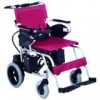生物谷报道:加州理工学院(Caltech)的科学家最近发明了一种自主运转的分子马达,它通过DNA聚合释放的自由能驱动。科学家的灵感来源于多种细菌病原例如立克次氏体,它们通过宿主细胞聚合蛋白质“彗尾”释放的能量驱动自己。研究小组通过将亚稳态的发夹DNA聚合成双链DNA实现对细菌的模拟。
研究结将果发表在最近一期的NatureNanotechnology上。
和之前的其它合成分子马达相比,新马达通过非共价相互作用驱动,且能在没有底物的溶液中自由运转。作者之一Niles Pierce说:“驱动的运动通过杂交链反应(HCR)实现,亚稳态发夹DNA和遇到的目标分子聚合。值得注意的是,在聚合物和发夹DNA发生连续相互作用时,被驱动的DNA相比不断生长的聚合物保持稳定。”
在模仿立克次氏体的“彗尾”过程中,科学家使用了原子力显微镜来显示矩形DNA一侧的聚合图案(这是最近由Paul Rothemund发明的构造纳米尺度物体的方法)。而科学家尚不清楚通过更完整的模仿立克次氏体功能,纳米级核酸单体聚合是否可以在溶液中自由驱动微观物体。
Pierce说:“研究证实了DNA聚合能为分子自主运动提供能量。来自NSF分子控制中心的科学家正在发展能对周围环境作出反应的逻辑分子。未来这些分子马达将可能用于医学、基础研究和制造业等。”(援引 教育部科技发展中心)
原文链接:http://www.physorg.com/news108291145.html
原始出处:
Nature Nanotechnology 2, 490 - 494 (2007)
Published online: 29 July 2007 | doi:10.1038/nnano.2007.225
Subject Categories: Molecular machines and motors | Nanobiotechnology
An autonomous polymerization motor powered by DNA hybridization
Suvir Venkataraman1, Robert M. Dirks1, Paul W. K. Rothemund2,3, Erik Winfree2,3 & Niles A. Pierce1,4
Abstract
We present a synthetic molecular motor capable of autonomous nanoscale transport in solution. Inspired by bacterial pathogens such as Rickettsia rickettsii, which locomote by inducing the polymerization of the protein actin at their surfaces to form 'comet tails'1, the motor operates by polymerizing a double-helical DNA tail2. DNA strands are propelled processively at the living end of the growing polymers, demonstrating autonomous locomotion powered by the free energy of DNA hybridization.
Department of Bioengineering, California Institute of Technology, Pasadena, California 91125, USA
Department of Computer Science, California Institute of Technology, Pasadena, California 91125, USA
Department of Computation & Neural Systems, California Institute of Technology, Pasadena, California 91125, USA
Department of Applied & Computational Mathematics, California Institute of Technology, Pasadena, California 91125, USA
Correspondence to: Niles A. Pierce1,4 e-mail: niles@caltech.edu







